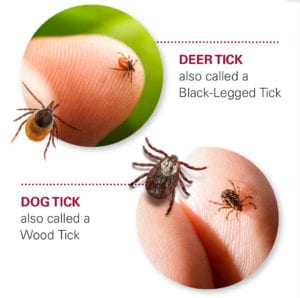Ticks are in full-force this season and cases of tick-borne diseases such as Lyme disease are on the rise. Use the information below to make sure you and your family are being tick smart.
 Identification
Identification
Deer Tick: Deer ticks are known to cause Lyme disease, anaplasmosis, babesiosis and Powassan.
Dog Tick: Dog ticks are not known to transmit Lyme disease.
Learn more about identifying ticks here: http://extension.umaine.edu/ipm/tickid/
Prevention
- Wear light-colored, long-sleeved clothing.
- Use insect repellent on skin or clothing.
- Do regular tick checks when returning inside.
- Protect furry friends with repellents and ask your vet about a Lyme disease vaccine.
Did you find an attached tick?
How big is the tick, pencil eraser or pencil tip?
Was the tick embedded into your skin?
Do you know how long the tick was embedded?
Do you have a rash?
Removal
- Using tweezers, grasp the tick close to the skin and gently pull until the tick lets go.
- Using a tick spoon, place the wide part of the notch on the skin near the tick. Apply downward pressure on the skin and slide the remover forward to frame the tick until it becomes detached. –Maine CDC
- Do not be concerned if the entire insect does not come out; it will work its way out. Do not dig for it.
- Some redness at the extraction site is normal.
- Clean the area around the bite and watch for any signs and symptoms for 30 days.
Symptoms
Symptoms include, but aren’t limited to:
- fever
- headache
- weakness
- fatigue
- body aches
- joint pain
- rash
- vomiting
- confusion
- loss of coordination
- speech difficulties
- changes in behavior
- seizures
If you remove an engorged deer tick, store it in a small container for potential testing and consult your primary care provider immediately.
